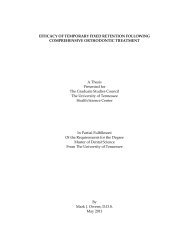BEVACIZUMAB EFFECT ON TOPOTECAN PHARMACOKINETICS ...
BEVACIZUMAB EFFECT ON TOPOTECAN PHARMACOKINETICS ...
BEVACIZUMAB EFFECT ON TOPOTECAN PHARMACOKINETICS ...
You also want an ePaper? Increase the reach of your titles
YUMPU automatically turns print PDFs into web optimized ePapers that Google loves.
tissue region renders microdialysis a powerful and appealing technology that is applied<br />
more and more in drug delivery and pharmacokinetic studies.<br />
1.5 The Effects of Anti-angiogenic Agents on the Pharmacokinetics of Cytotoxic<br />
Drugs<br />
1.5.1 The effects of anti-angiogenic agents on cytotoxic drugs disposition in solid<br />
tumors<br />
The effects of anti-angiogenic agents on cytotoxic drug disposition in solid<br />
tumors are paradoxical: Some investigators found that anti-angiogenic agents decrease<br />
the penetration of cytotoxic drugs into solid tumors; some indicated that anti-angiogenic<br />
agents increase the uptake of cytotoxic drugs into solid tumors, while others<br />
demonstrated that the delivery of cytotoxic drugs into solid tumors does not change after<br />
the administration of anti-angiogenic agents.<br />
Several studies showed pre-treatment with angiogenesis inhibitors decreased<br />
temozolomide (TMZ) concentration or exposure in rat glioma xenografts. In 1996, Dr.<br />
Gallo et al. examined the TMZ interstitial fluid concentration by using the microdialysis<br />
technique in a subcutaneous (SC) rat C6 glioma xenograft model after multiple doses of<br />
the angiogenesis inhibitor O-(N-chloroacetyl-carbamoyl)-fumagillol(TNP-470) [145].<br />
TNP-470 (30 mg/kg) was given SC on days 6, 8, 10, 12, and 14 following tumor<br />
implantation. On day 15, control (no TNP-470) and treated rats received 40 mg/kg of<br />
TMZ intra-arterially. Plasma and interstitial fluid samples were collected for 8 h and<br />
non-compartmental methods were used for pharmacokinetic modeling. The results of this<br />
study indicated that the mean TMZ area under the interstitial fluid concentration-time<br />
curve was reduced by 25% in the TNP-470-treated group compared to the control. In a<br />
subsequent study, the same group determined the tumor distribution of TMZ in SC and<br />
intracerebral (IC) rat glioma models with the overexpression of VEGF (V+) after<br />
anti-angiogenic agent TNP-470 [146] administration. TNP-470 (30 mg/kg) was<br />
administered to the animals SC every other day for total 5 doses (SC tumor model) or 4<br />
to 6 doses (IC model) which is coincided with the presentation of the central nervous<br />
system symptom [146]. The day after the last dose of TNP-470, TMZ was administrated<br />
intra-arterially to achieve steady-state plasma concentration of 40 μg/ml. The steady-state<br />
concentration of TMZ in tumor ECF and plasma as well as the concentration of TMZ<br />
metabolite 5-(3-methyltriazen-1-yl) imidazole-4-carboximide (MTIC) in tumor ECF were<br />
determined and microvessel density (MVD) was quantitated using an anti-CD31 method.<br />
In both the V+ SC and V+ IC models, significant reductions in TMZ tumor<br />
concentrations and tumor-to-plasma concentration ratios compared with control after<br />
TNP-470 treatment were observed, being reduced an average of 25% and 50% in the SC<br />
and IC tumors, respectively. MTIC concentrations in V+ SC tumors also were reduced by<br />
50% after TNP-470 administration. Consistent with the reduction of TMZ and MTIC<br />
concentration in tumor ECF, MVD was reduced by TNP-470 compared with vehicle<br />
control in the V+ SC and V+ IC tumors. Additionally, Gallo et al. also determined the<br />
13
















